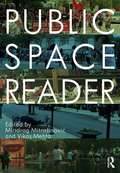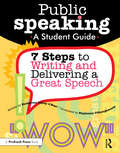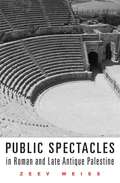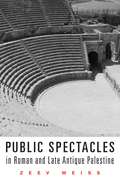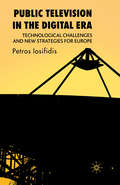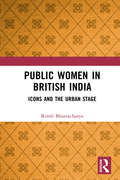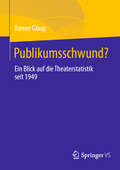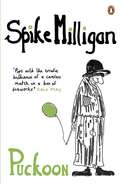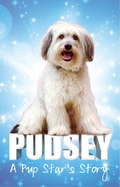- Table View
- List View
Public Space Reader
by Miodrag Mitrasinovi 263 Vikas MehtaRecent global appropriations of public spaces through urban activism, public uprising, and political protest have brought back democratic values, beliefs, and practices that have been historically associated with cities. Given the aggressive commodification of public re- sources, public space is critically important due to its capacity to enable forms of public dis- course and social practice which are fundamental for the well-being of democratic societies. Public Space Reader brings together public space scholarship by a cross-disciplinary group of academics and specialists whose essays consider fundamental questions: What is public space and how does it manifest larger cultural, social, and political processes? How are public spaces designed, socially and materially produced, and managed? How does this impact the nature and character of public experience? What roles does it play in the struggles for the just city, and the Right to The City? What critical participatory approaches can be employed to create inclusive public spaces that respond to the diverse needs, desires, and aspirations of individuals and communities alike? What are the critical global and comparative perspectives on public space that can enable further scholarly and professional work? And, what are the futures of public space in the face of global pandemics, such as COVID-19? The readers of this volume will be rewarded with an impressive array of perspectives that are bound to expand critical understanding of public space.
Public Space Reader
by Mitrašinović Miodrag Mehta VikasRecent global appropriations of public spaces through urban activism, public uprising, and political protest have brought back democratic values, beliefs, and practices that have been historically associated with cities. Given the aggressive commodification of public re- sources, public space is critically important due to its capacity to enable forms of public dis- course and social practice which are fundamental for the well-being of democratic societies. Public Space Reader brings together public space scholarship by a cross-disciplinary group of academics and specialists whose essays consider fundamental questions: What is public space and how does it manifest larger cultural, social, and political processes? How are public spaces designed, socially and materially produced, and managed? How does this impact the nature and character of public experience? What roles does it play in the struggles for the just city, and the Right to The City? What critical participatory approaches can be employed to create inclusive public spaces that respond to the diverse needs, desires, and aspirations of individuals and communities alike? What are the critical global and comparative perspectives on public space that can enable further scholarly and professional work? And, what are the futures of public space in the face of global pandemics, such as COVID-19? The readers of this volume will be rewarded with an impressive array of perspectives that are bound to expand critical understanding of public space.
Public Space Unbound: Urban Emancipation and the Post-Political Condition
by Sabine Knierbein Tihomir VidermanThrough an exploration of emancipation in recent processes of capitalist urbanization, this book argues the political is enacted through the everyday practices of publics producing space. This suggests democracy is a spatial practice rather than an abstract professional field organized by institutions, politicians and movements. Public Space Unbound brings together a cross-disciplinary group of scholars to examine spaces, conditions and circumstances in which emancipatory practices impact the everyday life of citizens. We ask: How do emancipatory practices relate with public space under ‘post-political conditions’? In a time when democracy, solidarity and utopias are in crisis, we argue that productive emancipatory claims already exist in the lived space of everyday life rather than in the expectation of urban revolution and future progress.
Public Space Unbound: Urban Emancipation and the Post-Political Condition
by Sabine Knierbein Tihomir VidermanThrough an exploration of emancipation in recent processes of capitalist urbanization, this book argues the political is enacted through the everyday practices of publics producing space. This suggests democracy is a spatial practice rather than an abstract professional field organized by institutions, politicians and movements. Public Space Unbound brings together a cross-disciplinary group of scholars to examine spaces, conditions and circumstances in which emancipatory practices impact the everyday life of citizens. We ask: How do emancipatory practices relate with public space under ‘post-political conditions’? In a time when democracy, solidarity and utopias are in crisis, we argue that productive emancipatory claims already exist in the lived space of everyday life rather than in the expectation of urban revolution and future progress.
Public Speaking: 7 Steps to Writing and Delivering a Great Speech (Grades 4-8)
by Katherine Pebley O'NealStudents write lots of reports, but how do they turn their hard work into appealing oral reports? Where can they learn to present their research with flair and style? Every student who will ever have to give an oral report needs the surefire techniques in this book. You'll find the basics of public speaking in clear language for children and busy teachers. Some of the topics covered are getting organized, preparing a great opener, using visual aids, involving the audience, and speaking with confidence. Public Speaking is a much needed resource that students, teachers, and parents can flip through or use cover-to-cover.In this book, students can learn how to organize information into a presentation that will interest and amaze their classmates. They will discover exciting ways to start a speech, and lots of intelligent techniques to use in the middle to keep the audience attentive. Here they will discover tricks to keep from getting nervous, and special, easy ways to remember what to say. Using these new skills, your students will be entertaining, informative, and confident.For more guidance on verbal presentation, see Speaker's Club.Grades 4-8
Public Speaking: 7 Steps to Writing and Delivering a Great Speech (Grades 4-8)
by Katherine Pebley O'NealStudents write lots of reports, but how do they turn their hard work into appealing oral reports? Where can they learn to present their research with flair and style? Every student who will ever have to give an oral report needs the surefire techniques in this book. You'll find the basics of public speaking in clear language for children and busy teachers. Some of the topics covered are getting organized, preparing a great opener, using visual aids, involving the audience, and speaking with confidence. Public Speaking is a much needed resource that students, teachers, and parents can flip through or use cover-to-cover.In this book, students can learn how to organize information into a presentation that will interest and amaze their classmates. They will discover exciting ways to start a speech, and lots of intelligent techniques to use in the middle to keep the audience attentive. Here they will discover tricks to keep from getting nervous, and special, easy ways to remember what to say. Using these new skills, your students will be entertaining, informative, and confident.For more guidance on verbal presentation, see Speaker's Club.Grades 4-8
Public Spectacles in Roman and Late Antique Palestine (Revealing Antiquity Ser. #21)
by Zeev WeissWishing to ingratiate himself with Rome, Herod the Great built theaters, amphitheaters, and hippodromes to bring pagan entertainments of all sorts to Palestine. Zeev Weiss explores how the indigenous Jewish and Christian populations responded, as both spectators and performers, to these cultural imports, which left a lasting imprint on the region.
Public Spectacles in Roman and Late Antique Palestine (Revealing Antiquity Ser. #21)
by Zeev WeissWishing to ingratiate himself with Rome, Herod the Great built theaters, amphitheaters, and hippodromes to bring pagan entertainments of all sorts to Palestine. Zeev Weiss explores how the indigenous Jewish and Christian populations responded, as both spectators and performers, to these cultural imports, which left a lasting imprint on the region.
Public Statues Across Time and Cultures (Routledge Research in Art History)
by Christopher P. DickensonThis book explores the ways in which statues have been experienced in public in different cultures and the role that has been played by statues in defining publicness itself. The meaning of public statues is examined through discussion of their appearance and their spatial context and of written discourses having to do with how they were experienced. Bringing together experts working on statues in different cultures, the book sheds light on similarities and differences in the role that public statues had in different times and places throughout history. The book will also provide insight into the diverse methods and approaches that scholars working on these different periods use to investigate statues. The book will appeal to historians, art historians and archaeologists of all periods who have an interest in the display of sculpture, the reception of public art or the significance of public monuments.
Public Statues Across Time and Cultures (Routledge Research in Art History)
by Christopher P. DickensonThis book explores the ways in which statues have been experienced in public in different cultures and the role that has been played by statues in defining publicness itself. The meaning of public statues is examined through discussion of their appearance and their spatial context and of written discourses having to do with how they were experienced. Bringing together experts working on statues in different cultures, the book sheds light on similarities and differences in the role that public statues had in different times and places throughout history. The book will also provide insight into the diverse methods and approaches that scholars working on these different periods use to investigate statues. The book will appeal to historians, art historians and archaeologists of all periods who have an interest in the display of sculpture, the reception of public art or the significance of public monuments.
Public Television in the Digital Era: Technological Challenges and New Strategies for Europe
by P. IosifidisBy looking at a range of different European Public Television (PTV) broadcasters, this book investigates the challenges that these broadcasters encounter in a competitive digital broadcasting environment and reveals the different policies and strategies that they are adopting in order to remain accountable, competitive and efficient.
Public Theatre and the Enslaved People of Colonial Saint-Domingue
by Julia PrestThe French colony of Saint-Domingue (now Haiti) was home to one of the richest public theatre traditions of the colonial-era Caribbean. This book examines the relationship between public theatre and the enslaved people of Saint-Domingue—something that is generally given short shrift owing to a perceived lack of documentation. Here, a range of materials and methodologies are used to explore pressing questions including the ‘mitigated spectatorship’ of the enslaved, portrayals of enslaved people in French and Creole repertoire, the contributions of enslaved people to theatre-making, and shifting attitudes during the revolutionary era. The book demonstrates that slavery was no mere backdrop to this portion of theatre history but an integral part of its story. It also helps recover the hidden experiences of some of the enslaved individuals who became entangled in that story.
Public Women in British India: Icons and the Urban Stage
by Rimli BhattacharyaThis book foregrounds the subjectivity of ‘acting women’ amidst violent debates on femininity and education, livelihood and labour, sexuality and marriage. It looks at the emergence of the stage actress as an artist and an ideological construct at critical phases of performance practice in British India. The focus here is on Calcutta, considered the ‘second city of the Empire’ and a nodal point in global trade circuits. Each chapter offers new ways of conceptualising the actress as a professional, a colonial subject, simultaneously the other and the model of the ‘new woman’. An underlying motif is the playing out of the idea of spiritual salvation, redemption and modernity. Analysing the dynamics behind stagecraft and spectacle, the study highlights the politics of demarcation and exclusion of social roles. It presents rich archival work from diverse sources, many translated for the first time. This book makes a distinctive contribution in intertwining performance studies with literary history and art practices within a cross-cultural framework. Interdisciplinary and innovative, it will appeal to scholars and researchers in South Asian theatre and performance studies, history and gender studies.
Public Women in British India: Icons and the Urban Stage
by Rimli BhattacharyaThis book foregrounds the subjectivity of ‘acting women’ amidst violent debates on femininity and education, livelihood and labour, sexuality and marriage. It looks at the emergence of the stage actress as an artist and an ideological construct at critical phases of performance practice in British India. The focus here is on Calcutta, considered the ‘second city of the Empire’ and a nodal point in global trade circuits. Each chapter offers new ways of conceptualising the actress as a professional, a colonial subject, simultaneously the other and the model of the ‘new woman’. An underlying motif is the playing out of the idea of spiritual salvation, redemption and modernity. Analysing the dynamics behind stagecraft and spectacle, the study highlights the politics of demarcation and exclusion of social roles. It presents rich archival work from diverse sources, many translated for the first time. This book makes a distinctive contribution in intertwining performance studies with literary history and art practices within a cross-cultural framework. Interdisciplinary and innovative, it will appeal to scholars and researchers in South Asian theatre and performance studies, history and gender studies.
Publikumsschwund?: Ein Blick auf die Theaterstatistik seit 1949
by Rainer GlaapDurch den teils massiven Publikumsschwund nach der Pandemie stellt sich die Frage, ob diese als Brandbeschleuniger gewirkt hat für bereits vorhandene Trends. Der Autor geht dem nach anhand der Besuchszahlen bis zur letzten vollständigen vorpandemischen Spielzeit 2018/19. Er zeigt historische Zeitreihen zu Sparten- und Personalentwicklung, Vertriebskanälen und den Einnahmen. Die Theaterstatistik des Bühnenvereins dient vielen Entscheidungsträgern als Grundlage für z.B. kulturpolitische Steuerungen, obwohl sie nicht die komplette deutsche Theaterlandschaft abbildet. Deshalb beleuchtet der Autor weitere Anbieter. Da die Theaterstatistik große kulturpolitische Bedeutung hat, gibt es zum Schluss einige Vorschläge für die Zukunft.
Publishing Networks in France in the Early Era of Print (The History of the Book)
by Diane E. BootonThis book examines commercial and personal connections in the early modern book trade in Paris and northwestern France, ca. 1450–1550. The book market, commercial trade, and geo-political ties connected the towns of Paris, Caen, Angers, Rennes, and Nantes, making this a fertile area for the transference of different fields of knowledge via book culture. Diane Booton investigates various aspects of book production (typography and illustration), market (publishers and booksellers), and ownership (buyers and annotators) and describes commercial and intellectual dissemination via established pathways, drawing on primary and archival sources.
Publishing Networks in France in the Early Era of Print (The History of the Book)
by Diane E. BootonThis book examines commercial and personal connections in the early modern book trade in Paris and northwestern France, ca. 1450–1550. The book market, commercial trade, and geo-political ties connected the towns of Paris, Caen, Angers, Rennes, and Nantes, making this a fertile area for the transference of different fields of knowledge via book culture. Diane Booton investigates various aspects of book production (typography and illustration), market (publishers and booksellers), and ownership (buyers and annotators) and describes commercial and intellectual dissemination via established pathways, drawing on primary and archival sources.
Puckoon
by Spike MilliganPuckoon is Spike Milligan's classic slapstick novel, reissued for the first time since it was published in 1963.'Pops with the erratic brilliance of a careless match in a box of fireworks' Daily MailIn 1924 the Boundary Commission is tasked with creating the new official division between Northern Ireland and the Irish Republic. Through incompetence, dereliction of duty and sheer perversity, the border ends up running through the middle of the small town of Puckoon.Houses are divided from outhouses, husbands separated from wives, bars are cut off from their patrons, churches sundered from graveyards. And in the middle of it all is poor Dan Milligan, our feckless protagonist, who is taunted and manipulated by everyone (including the sadistic author) to try and make some sense of this mess . . .'Bursts at the seams with superb comic characters involved in unbelievably likely troubles on the Irish border' Observer'Our first comic philosopher' Eddie IzzardSpike Milligan was one of the greatest and most influential comedians of the twentieth century. Born in India in 1918, he served in the Royal Artillery during WWII in North Africa and Italy. At the end of the war, he forged a career as a jazz musician, sketch-show writer and performer, before joining forces with Peter Sellers and Harry Secombe to form the legendary Goon Show. Until his death in 2002, he had success as on stage and screen and as the author of over eighty books of fiction, memoir, poetry, plays, cartoons and children's stories.
Pudsey: A Pup Star's Story
by PudseyLast year, a dog danced his way into the history books as the first canine winner of Britain's Got Talent. On their way to the title, Pudsey and his owner Ashleigh Butler won over Walliams, delighted Dixon, stole the heart of Holden, and utterly captivated Cowell. They charmed the nation, too - with millions of families tuning in to see them take the crown.As a young pup, Pudsey always knew he was somehow different to other puppies. While his brothers and sisters contented themselves with chasing their tails, he sat apart, hoping for something more. Pudsey: A Pup Star's Story tells the story of his incredible, inspirational journey, straight from the dog's mouth.
Pueblo Style and Regional Architecture (Routledge Revivals)
by Nicholas C. Markovich Wolfgang F. Preiser Fred G. SturmFew architectural styles evoke so strong a sense of place as Pueblo architecture. This book brings together experts from architecture and art, archaeology and anthropology, philosophy and history, considering Pueblo style not simply architecturally, but within its cultural, religious, economic, and climate contexts as well. The product of successive layers of Pueblo Indian, Spanish, and Anglo influences, contemporary Pueblo style is above all seen as a harmonious response to the magnificent landscape from which it emerged. Pueblo Style and Regional Architecture, first published in 1990, is a unique and thorough study of this enduring regional style, a sourcebook that will inform and inspire architects and designers, as well as fascinate those interested in the anthropology, culture, art, and history of the American Southwest.
Pueblo Style and Regional Architecture (Routledge Revivals)
by Nicholas C. Markovich Wolfgang F. Preiser Fred G. SturmFew architectural styles evoke so strong a sense of place as Pueblo architecture. This book brings together experts from architecture and art, archaeology and anthropology, philosophy and history, considering Pueblo style not simply architecturally, but within its cultural, religious, economic, and climate contexts as well. The product of successive layers of Pueblo Indian, Spanish, and Anglo influences, contemporary Pueblo style is above all seen as a harmonious response to the magnificent landscape from which it emerged. Pueblo Style and Regional Architecture, first published in 1990, is a unique and thorough study of this enduring regional style, a sourcebook that will inform and inspire architects and designers, as well as fascinate those interested in the anthropology, culture, art, and history of the American Southwest.
Puerto Rico Is in the Heart: Emigration, Labor, And Politics In The Life And Work Of Frank Espada
by E. CarvalhoSet against the backdrop of contemporary US economic history, Puerto Rico Is in the Heart examines the emigration, labor, and political experiences of documentary photographer, human rights activist, and Puerto Rican community leader Frank Espada and considers the cultural impact of neoliberal programs directed at Puerto Rico and Puerto Ricans.
Pulling Focus: Intersubjective Experience, Narrative Film, and Ethics
by Jane StadlerThe most powerful films have an afterlife. Their sensory appeal and their capacity to elicit involvement in story, character and conflict reaches beyond the screen to subtly reframe the way spectators view ethical issues and agents within the narrative, and in the world outside the cinema. Pulling Focus: Intersubjective Experience and Narrative Film questions how cinematic narratives relate to and affect ethical life. Extending Martha Nussbaum and Wayne Booth's work on moral philosophy and literature to consider cinema, Dr. Stadler shows that film spectatorship can be understood as a model for ethical attention that engages the audience in an affective relationship with characters and their values. Building on Vivian Sobchack's Address of the Eye and Carnal Thoughts, she uses a phenomenological approach to analyse ethical dimensions of film extending beyond narrative content, arguing that the camera describes experience and views screen characters with an evaluative form of perception: an ethical gaze in which spectators participate. Films discussed include Dead Man Walking, Lost Highway, Batman Begins, Nil By Mouth, and Eternal Sunshine of the Spotless Mind.
Pulp and Other Plays by Tasha Fairbanks
by Elaine Aston Gabriele GriffinFirst Published in 2004. Routledge is an imprint of Taylor & Francis, an informa company.
Pulp and Other Plays by Tasha Fairbanks
by Gabriele Griffin Elaine AstonFirst Published in 2004. Routledge is an imprint of Taylor & Francis, an informa company.
